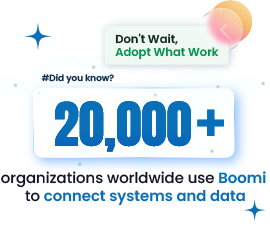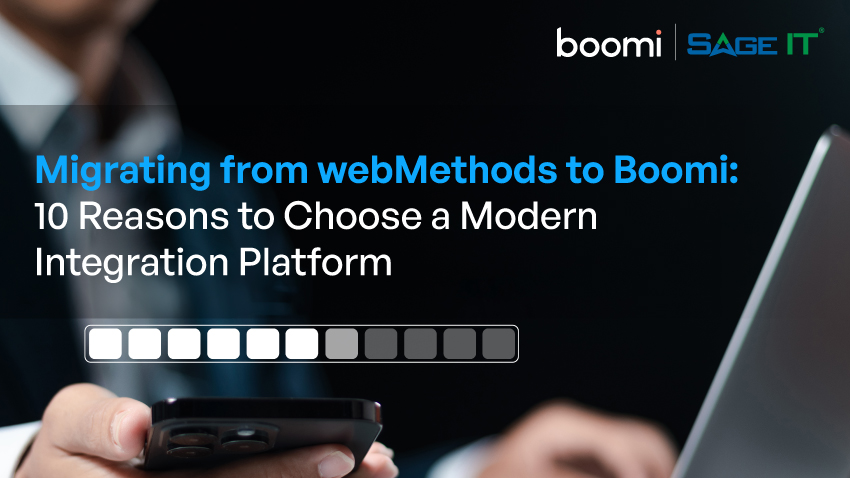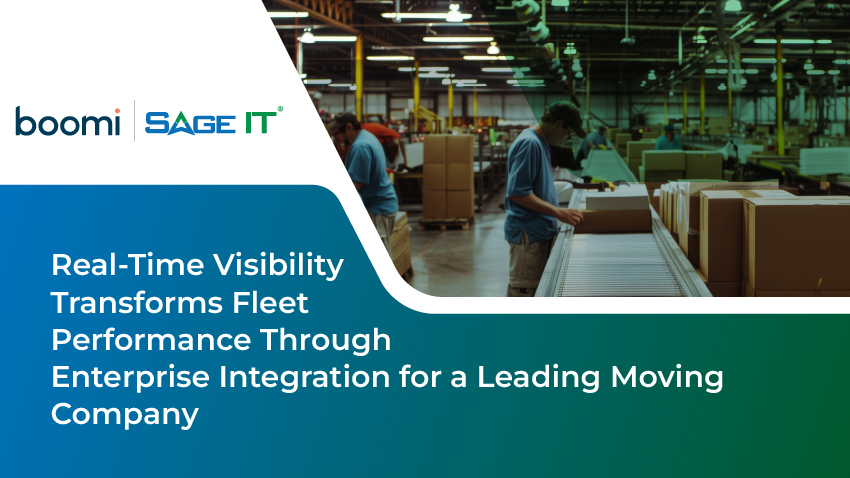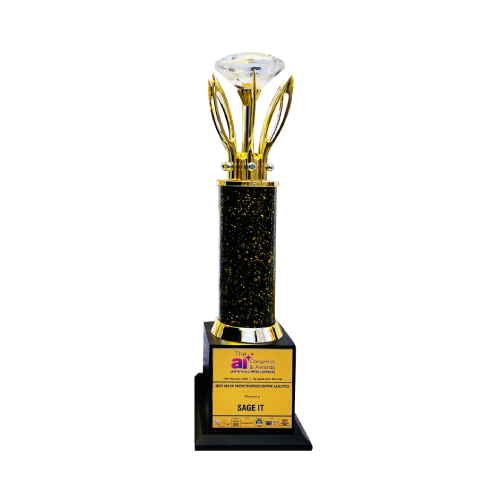Supply chain disruptions continue to challenge businesses, and 45.1% of organizations now view automation as critical. KPMG forecasts ongoing disruptions through 2023, with 58.6% of retail executives investing in omnichannel fulfillment. Optimizing and automating supply chain processes is increasingly necessary.
Boomi automates supply chain management by integrating systems like ERP, CRM, and IoT devices without complex reconfiguration. This automation offers real-time data visibility, connecting your operations for smarter decision-making. Boomi solves issues like legacy system compatibility and data silos. It automates workflows, syncs data across platforms securely, and provides full visibility. By automating complex tasks, Boomi helps organizations achieve operational excellence. Continue reading for details on how Boomi optimizes your supply chain.
What Is Supply Chain Automation?
Supply chain automation uses advanced technologies to improve operations, reduce manual tasks, and maximize performance across the supply chain. It incorporates tools like IoT, AI, ML, and APIs to enable real-time data processing, automated workflows, and smooth integration of various systems. This approach not only increases accuracy and speed but also maintains consistent data flow between critical systems like ERP, CRM, and WMS.
Technologies Driving Supply Chain Automation
The Internet of Things (IoT)
The Internet of Things (IoT) is vital in modern supply chains, offering real-time tracking of assets, inventory, and vehicles. IoT devices collect large amounts of data, giving companies more visibility and control over their operations. Boomi integrates this IoT data through its IoT Edge technology, allowing data flow into supply chain management systems. This setup supports real-time monitoring and predictive maintenance, helping to prevent disruptions and optimize inventory management.
Artificial Intelligence (AI) and Machine Learning (ML)
Artificial Intelligence (AI) and Machine Learning (ML) have changed supply chain automation by offering predictive analytics and automated decision-making. These technologies examine historical data to forecast demand, adjust inventory levels, and anticipate supply chain issues. Boomi supports these capabilities with AI-driven data mapping and machine learning algorithms. This setup automates data processing and allows for adjustments based on real-time insights, keeping supply chains responsive.
Robotics and Automation in Warehousing
In warehouses, robotics and automation are key to making operations smoother. Automated Guided Vehicles (AGVs) and robotic arms handle tasks like picking, packing, and sorting, reducing the need for manual labor and minimizing errors. Boomi supports this automation through API-based connectivity, linking robotic systems with other supply chain components. This setup improves data exchange and warehouse performance, enhancing overall efficiency and safety.
ERP Modernization and Cloud Integration
The modernization of ERP systems and their integration into cloud environments is crucial for automating supply chain processes. Modern ERPs provide centralized data management and support real-time decision-making, essential for aligning various supply chain functions.
Boomi’s cloud-native integration tools facilitate ERP modernization, connecting on-premises systems with cloud-based applications. This integration enhances data access, scalability, and collaboration across departments, which is vital for keeping a responsive supply chain.
Electronic Data Interchange (EDI) Modernization
Electronic Data Interchange (EDI) remains central for automating business document exchanges between partners, reducing manual processing and errors. Boomi modernizes EDI systems with its B2B/EDI Management capabilities, supporting faster and more reliable data exchanges across the supply chain. This update improves communication, reduces processing delays, and facilitates smoother operations.
Application Programming Interfaces (APIs)
Application Programming Interfaces (APIs) are essential for connecting different software applications, enabling data sharing and automation across various systems. Boomi’s API management platform supports this integration, ensuring smooth data flows and improving supply chain operations. By deploying scalable and secure APIs, businesses maintain interconnected supply chains that adjust to evolving needs.
How to Automate Your Supply Chain with Boomi
Step 1: Identify Boomi’s Capabilities in Supply Chain Management
- Boomi’s cloud-based Integration Platform as a Service (iPaaS) facilitates integration between various supply chain systems, such as ERP (Enterprise Resource Planning), WMS (Warehouse Management Systems), TMS (Transportation Management Systems), and OMS (Order Management Systems). With over 200 pre-built connectors, Boomi allows for real-time data synchronization and interoperability across your supply chain, enhancing visibility and decision-making capabilities.
- Boomi Flow is a low-code development platform that enables the automation of complex workflows and business processes. For supply chain management, this means automating tasks like order processing, inventory replenishment, supplier notifications, and shipment tracking—reducing manual touchpoints and minimizing errors.
- This feature provides tools for data transformation, cleansing, and enrichment, crucial for accurate analytics and reporting. In supply chain terms, this enables better demand forecasting, inventory optimization, and supplier performance management by ensuring data consistency and quality across systems
Step 2: Develop a Strategic Implementation Plan
- Begin by creating a detailed process map of your current supply chain workflows, including inventory management, procurement, order fulfillment, and logistics. Identify where data silos, manual interventions, and inefficiencies exist. This will help you target specific areas where Boomi’s integration and automation capabilities can bring the most value.
- Define specific objectives, such as improving forecast accuracy by 20%, reducing order processing time by 30%, or increasing on-time delivery rates by 15%. These goals will guide your use of Boomi’s capabilities and ensure alignment with your supply chain strategy.
Step 3: Choose the Right Automation Solutions
- Evaluate automation tools based on their ability to integrate seamlessly with your existing supply chain technology stack, such as your ERP, CRM (Customer Relationship Management), SCM (Supply Chain Management), and IoT (Internet of Things) devices. Boomi’s platform supports API-led connectivity, which is critical for enabling these systems to communicate and share data without custom coding.
- Boomi’s flexible architecture allows for extensive customization to meet the specific needs of your supply chain operations. For example, you can use Boomi to create custom data mappings between your TMS and WMS, automate EDI (Electronic Data Interchange) transactions for supplier communications, or build tailored workflows that integrate IoT sensor data into your ERP for real-time asset tracking.
Step 4: Pilot Boomi in a Controlled Environment
- Select a specific supply chain process or department to start your Boomi implementation. For example, begin with automating the order-to-cash process, integrating your OMS with your ERP and CRM systems through Boomi’s connectors to streamline order fulfillment and customer communications.
- Use Boomi’s real-time monitoring tools to track key performance indicators (KPIs) such as order cycle time, inventory turnover, and delivery lead time. Adjust configurations based on data insights to optimize performance and ensure that the automation meets your supply chain objectives.
Step 5: Scale Your Automation Efforts
- Once the pilot is successful, use Boomi AtomSphere to extend automation capabilities to other parts of the supply chain, such as procurement, warehousing, and logistics. For example, automate purchase order processing from your ERP to your supplier’s systems, and integrate IoT data from warehouse sensors into your WMS for real-time inventory management.
- Boomi’s scalable, cloud-native architecture is designed to handle increasing data volumes and more complex workflows as your supply chain expands. Plan for future growth by leveraging Boomi’s capabilities to support additional supply chain nodes, new partners, and evolving business needs.
Step 6: Train Your Team
- Enroll your supply chain team in Boomi University to gain certifications and hands-on experience with the platform. Courses cover a range of topics from basic integration setup to advanced data management and API creation, ensuring your team is well-equipped to handle the platform’s capabilities.
- Encourage your team to engage with the Boomi Community to learn from other users’ experiences and best practices. This interaction can be valuable for problem-solving, discovering innovative use cases, and keeping up with the latest platform updates.
Step 7: Consider Partnering with a Boomi Implementation Expert
- Partnering with a Boomi implementation expert can help accelerate your supply chain automation efforts. These experts understand the nuances of integrating Boomi with complex supply chain technologies and can provide insights that reduce implementation time and avoid common pitfalls.
- An implementation partner can customize Boomi to your specific supply chain requirements, such as integrating multiple ERP systems across different regions or automating compliance reporting for global operations. They also offer ongoing support to ensure your automation strategy evolves with your business needs and continues to deliver value.
How To Overcome Challenges in Supply Chain Automation with Boomi
1. Scalability and Integration Complexity
Large enterprises manage extensive IT infrastructures with multiple legacy systems, cloud services, and third-party applications. Coordinating these systems across various suppliers, logistics partners, and internal departments can become increasingly complex and resource-intensive, particularly as the business scales. An example would be integrating a new supplier’s system with an existing ERP platform without disrupting the flow of operations.
Boomi’s Solution:
Boomi’s Integration Platform as a Service (iPaaS) offers a cloud-native solution that connects diverse applications and data sources. By using Boomi’s pre-built connectors and a broad library of integration tools, businesses achieve real-time data synchronization across all operations, from procurement to delivery. This approach reduces the workload on IT teams and allows for quicker adaptation to changes, supporting scalability without extensive custom development.
2. Data Governance and Security
Tech leaders must maintain strong data governance and security, particularly in regulated industries like pharmaceuticals or finance. Confirming that all data exchanged between manufacturers, suppliers, and logistics providers is secure and complies with industry regulations is critical. A breach in data security can expose sensitive supplier information or disrupt the flow of goods, leading to costly delays and penalties.
Boomi’s Solution
Boomi provides an integration environment that meets enterprise security standards and compliance protocols. With built-in data governance features and end-to-end encryption, Boomi ensures that data shared across various channels is secure and compliant with regulations like GDPR, HIPAA, and CCPA. The platform’s monitoring and alerting capabilities allow tech leaders to manage data flows and prevent breaches, maintaining the integrity of all transactions and communications.
3. Operational Efficiency and Cost Management
Maintaining operations while controlling costs is a continual challenge for large enterprises, where manual processes and disconnected systems can lead to inefficiencies and increased expenses. An example would be manually reconciling inventory data across multiple warehouses, which can result in errors, delays, and higher operational costs.
Boomi’s Solution:
Boomi’s platform automates manual processes and connects various systems, from order management to inventory tracking. By automating workflows and providing real-time data access, Boomi minimizes manual data entry and reconciliation, reducing operational costs and errors. This automation helps tech leaders allocate resources effectively and boost productivity, ensuring that all operations run smoothly and cost-effectively.
Step 4: Pilot Boomi in a Controlled Environment
Access to real-time data is crucial for tech leaders to make informed decisions. Timely insights can mean the difference between meeting customer demands and facing stockouts or overstock. A delay in receiving real-time sales data could prevent a retailer from quickly adjusting their stock levels in response to a sudden surge in demand, leading to lost sales or excess inventory.
Boomi’s Solution:
Boomi allows real-time data integration and processing, ensuring businesses have current information across all systems, from procurement to logistics. This visibility supports better decision-making by offering a full view of operations, allowing for quick adjustments to inventory levels, supplier orders, and delivery schedules. Boomi’s data transformation capabilities ensure accuracy and consistency, enhancing decision-making processes in fast-paced environments.
Conclusion
ServiceNow is a game-changer for businesses. It replaces tedious manual tasks with seamless automation, identifies and addresses issues proactively, and confirms robust data security. With integrated systems, communication becomes efficient, and incident management is swift, reducing downtime.
The self-service portal empowers users to find solutions quickly, improving satisfaction. ServiceNow integrates seamlessly with various systems, providing a scalable solution for businesses of all sizes. It also boosts productivity through centralized IT assets and automated processes.
Ready to transform your business operations with ServiceNow? Start your journey today and see the benefits firsthand. For expert guidance, contact us now.

